Contents
What Are the Sustainable Development Goals (SDGs)?
The Sustainable Development Goals (SDGs) are a set of international development goals that were listed in the 2030 Agenda for Sustainable Development, which was adopted by the UN Sustainable Development Summit held in September 2015.
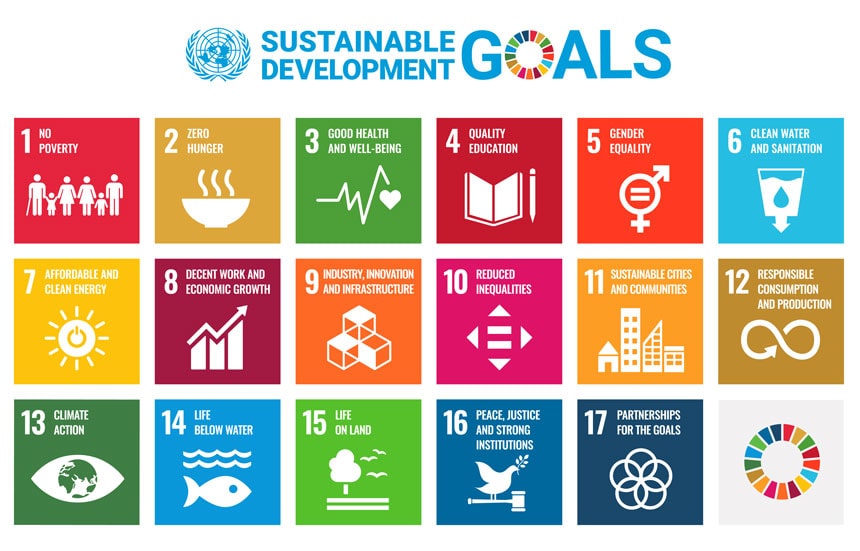
The SDGs consist of 17 goals for creating a better, sustainable world by 2030. To achieve these goals, we need to work on a wide range of efforts—from communal activities to social reform at large—including environmental considerations, work style transformation, and the promotion of health.
Source: Ministry of Foreign Affairs of Japan “What are the SDGs?”
In this blog post, we introduce Contec’s various efforts along with the applications of IoT, AI, and other digital technologies in relation to SDGs initiatives.
The Significance of Societal Efforts for Achieving SDGs
In December 2016, the Ministry of Foreign Affairs of Japan announced the SDGs Implementation Guiding Principles (Japanese), which lists the particular issues that Japan will focus on.
(Japanese), which lists the particular issues that Japan will focus on.
Eight Priority Areas
Empowerment of All People
Achievement of Good Health and Longevity
Creating Growth Market, Revitalization of Rural Areas, and Promoting Technological Innovation
Sustainable and Resilient Land Use, Promoting High Quality Infrastructure
Energy Conservation, Renewable Energy, Climate Change Countermeasures, and Sound Material-Cycle Society
Conservation of Environment, including Biodiversity, Forests and Oceans
Achieving Peaceful, Safe and Secure Societies
Strengthening the Means and Frameworks of the Implementation of the SDGs
As responsible members of the international community, enterprises are required to engage in activities aimed at achieving SDGs. Working on SDGs through business is understood to be critical for enterprises to improve their corporate values while honing their competitiveness. In today’s world where IoT and AI are beginning to penetrate production sites and social infrastructure, promoting innovations that draw on digital technologies may be a breakthrough on a variety of social issues, including the effective use of energy and work style reform.
Relationship between SDGs and IoT/AI
The adoption and application of digital technologies such as IoT and AI are garnering attention as corporate undertakings aimed at attaining SDGs. The third of the eight priority areas, “Creating Growth Market, Revitalization of Rural Areas, and Promoting Technological Innovation,” possibly needs efficient application of IoT and AI in addition to the development of new technologies.
Let’s take a look at specific IoT applications for each of the SDGs.
What IoT/AI Can Achieve
Adopting IoT and AI in corporate production activities and social infrastructure can lead to the creation of new value and the incubation of products and services that cater to the needs of customers. This can promote corporate growth and resolve social issues at the same time.
System for Applying IoT and AI
- (1) Use IoT to collect environmental information, operation statuses, and people’s movements as data.
- (2) Use AI to analyze collected information (big data).
- (3) Use the findings for controlling facilities and for delivery and maintenance services.
Examples of IoT/AI Applications
The following are some real-life examples of how IoT and AI are being used to resolve issues and create new businesses.
Manufacturing Industry
- AI-based order forecasting and automated production planning
- Digitization and standardization of expert know-how
- Productivity improvements and labor savings by introducing robots
Energy
- Optimal operation of power-generation facilities using AI control
- Optimal energy demand forecasting using AI analysis
- Operation of facilities with the aim to reduce GHG emissions or attain zero emissions
Dairy Farming
- Collection of animal rearing and environmental information by introducing IoT
- Automation and optimization of rearing plans based on animal condition predictions
- Sharing and application of experience and know-how
Agriculture
- Collection of crop farming and environmental information by introducing IoT
- Optimization of environmental control at plant factories and for growing in greenhouses
- AI prediction of yield linked to market needs
Introducing Contec’s Solutions
IoT-based Production Line (Komaki Factory)
Contec has been promoting the adoption of IoT at its factory in Komaki, Aichi Prefecture. At the initial stage of introducing the IoT system, the focus was on visualizing the production process to help improve work efficiency. However, through our improvement activities, we effectively adopted IoT in a wide range of areas, including energy monitoring and regenerative energy recovery systems for a decarbonized society, and we also established a more worker-friendly environment.
Configuration Image of Factory IoT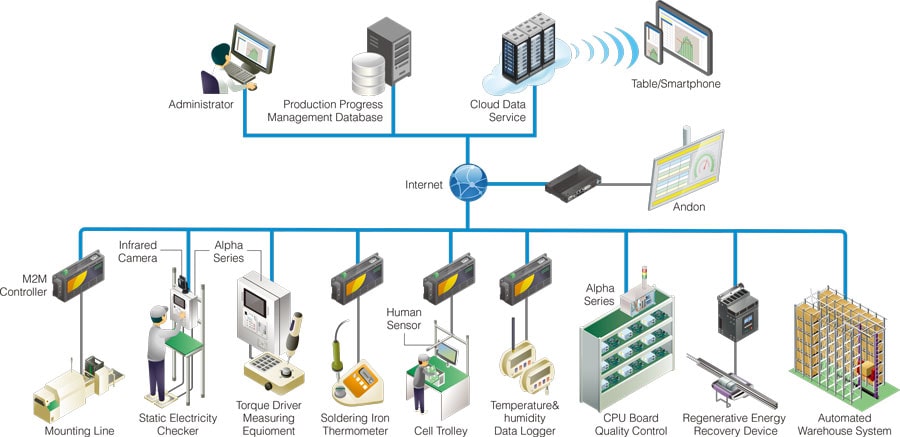
Factory Image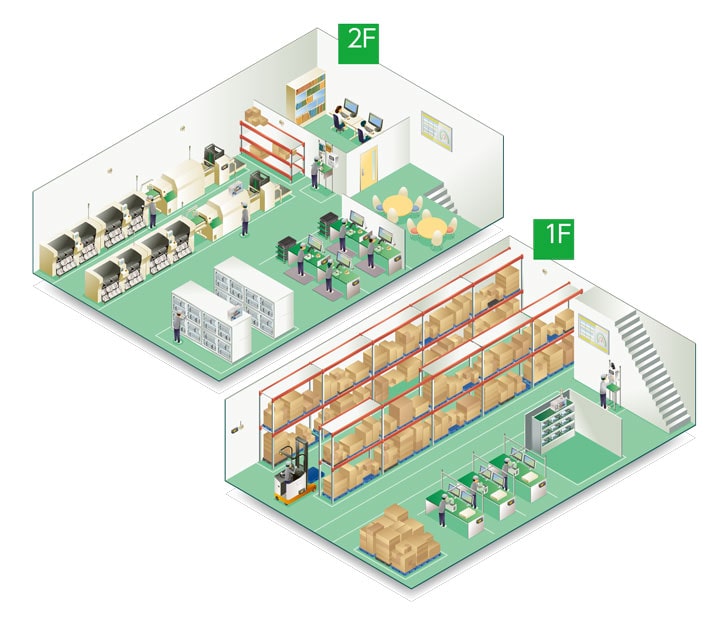
River & Floodgate Monitoring System
The image below shows a river and floodgate monitoring system that utilizes the CONPROSYS™ series, one of Contec’s M2M/IoT solutions. Through the optimal combination of IoT technologies—such as edge computing, communications lines, and a cloud system—we achieved real-time river monitoring and remote facility control. Not only does this improve the work efficiency of river monitoring operations, but it also contributes to ensuring people’s safety and better city development.
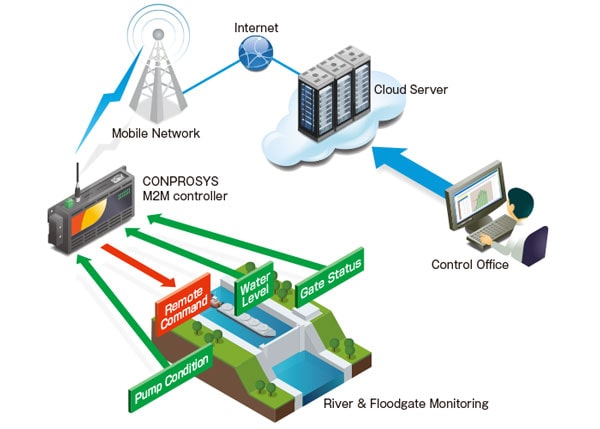 Configuration Image of River & Floodgate Monitoring System
Configuration Image of River & Floodgate Monitoring System
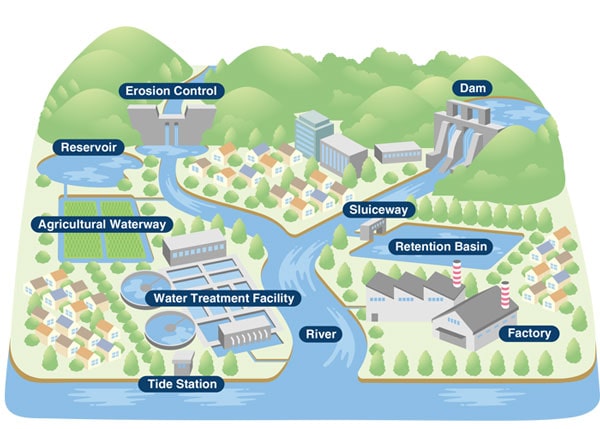 River Monitoring Applications
River Monitoring Applications
AI Hand-washing Judgment System
This hand-washing judgment system uses AI to recognize correct hand-washing procedure from images taken with a 3D camera. Recognizing hand-washing motions with AI-based image processing technology makes it possible to keep records of the implementation of correct hand-washing at sites where sanitation management is required, such as restaurants, food factories, and medical sites.
In addition to improving sanitation management operations, this system also contributes to people’s health, food safety, and other social aspects.
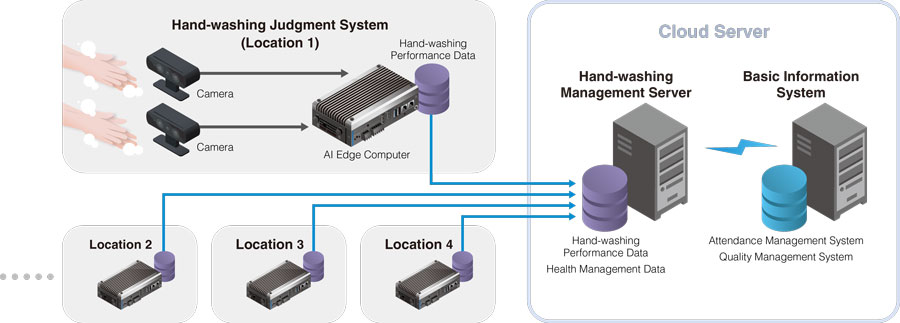
Solar Power and Renewable Energy
Renewable energy is an important low-carbon energy source that can be produced within the country with no GHG emissions. The in-house consumption control function using solar power generation is currently garnering attention. The in-house consumption control function controls power use by minimizing electricity purchasing from the power company while maximizing the use of renewable energy.
Contec’s SolarView SC applies an AI control system that optimizes solar power generation based on power consumption, power generation, and battery system conditions.
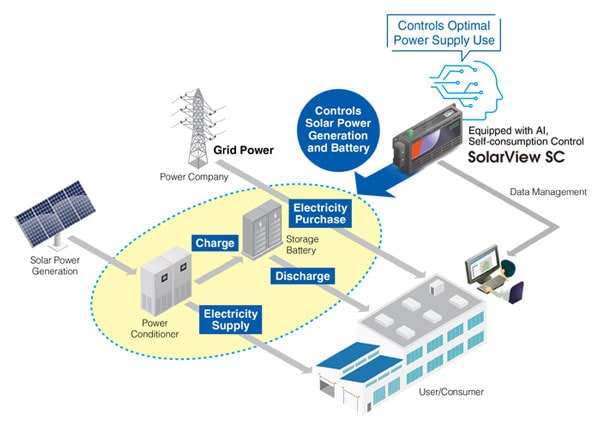 Equipped with AI, Self-consumption Control-SolarView SC
Equipped with AI, Self-consumption Control-SolarView SC
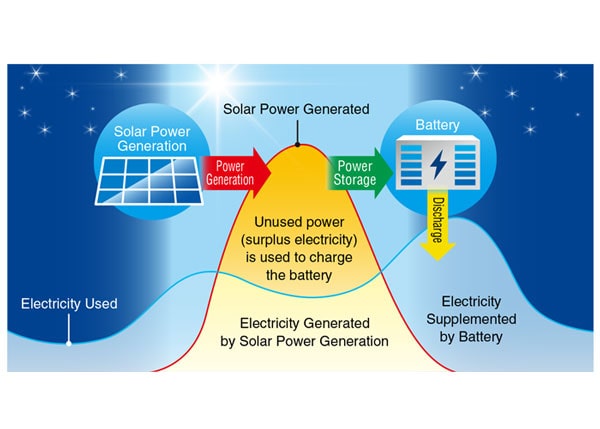 Control Image of Storage Battery System
Control Image of Storage Battery System
Remote Facility Monitoring System
Many factory and infrastructure facilities use programmable logic controllers (PLCs) for system control. FacilityView for PLC is a cloud-based software service (SaaS) that can be used simply by connecting a gateway terminal to the PLC to enable the creation of a system that stores and visualizes data and sends event messages.
Because FacilityView for PLC is a subscription service (with an annual fee), it can help introduce systems in a diverse range of fields and applications where customers wish to utilize IoT, such as remote facility monitoring, optimization of facility maintenance and consumables supply tasks, and maintenance and management of social infrastructure.
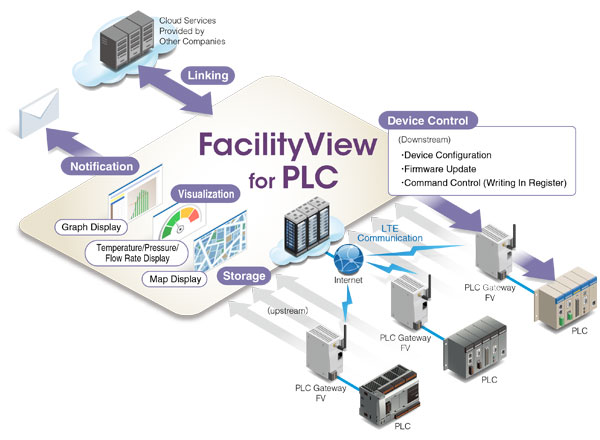 Cloud-based Equipment Monitoring Package
Cloud-based Equipment Monitoring Package
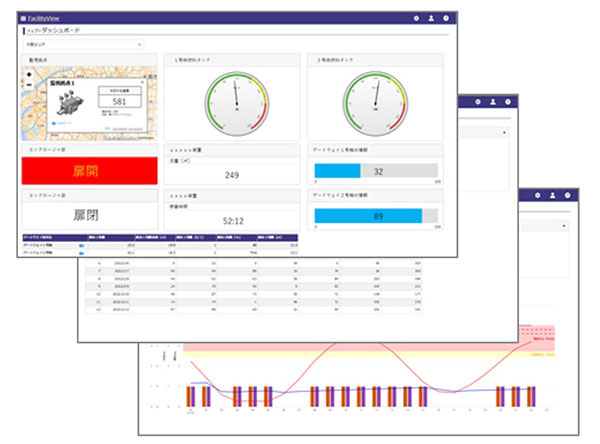 Screen Image of FacilityView for PLC
Screen Image of FacilityView for PLC
Daifuku Group Initiatives
Contec Co., LTD. is a wholly owned subsidiary of Daifuku Co., Ltd . Hini Arata Kan
. Hini Arata Kan is Daifuku's full-scale demo center where visitors can experience material handling systems and equipment firsthand. The facility implemented a carbon offset program toward achieving zero CO2 emissions in 2014.
is Daifuku's full-scale demo center where visitors can experience material handling systems and equipment firsthand. The facility implemented a carbon offset program toward achieving zero CO2 emissions in 2014.
Photovoltaic System
Daifuku installed solar panels on the roof of Hini Arata Kan. The system generated approximately 270,000 kWh of power, which reduced CO2 emissions by 110 tons.
Carbon Offset
Since 2014, Hini Arata Kan has offset 100% of the yearly CO2 emissions generated from electricy and LPG use at the center and shuttle busses (including the use of biodiesel fuel).
Conclusions
This blog post introduced Contec’s SDGs efforts and the applications of digital technologies. SDGs are goals being sought by the whole world to achieve a sustainable society. Various activities are being undertaken not only in Japan but in all parts of the world.
In Singapore, efforts to combat climate change have been mentioned as a major focus of future policies in the Prime Minister’s National Day Rally speech in August 2020. The country has also announced the environmental action plan, Singapore Green Plan 2030 (February 10, 2021), as one of the specific policies. This plan presents a policy to secure environmentally-friendly energy sources in order to support clean-energy mobility while also developing and maintaining a sustainable environment to protect the lives of people. Singapore is also seeing an emergence of new business opportunities such as green finance, which is meant to procure funds necessary for the environmental action plan.
(February 10, 2021), as one of the specific policies. This plan presents a policy to secure environmentally-friendly energy sources in order to support clean-energy mobility while also developing and maintaining a sustainable environment to protect the lives of people. Singapore is also seeing an emergence of new business opportunities such as green finance, which is meant to procure funds necessary for the environmental action plan.
Utilization of advanced digital technologies such as IoT and AI can be key to creating new businesses and promoting growth for enterprises. Why not consider renewing your business model by leveraging digital technologies as a step toward achieving SDGs?
Drawing on our time-proven electronics manufacturing know-how and the latest cloud service and AI technologies, Contec offers products that customers can feel confident about introducing to their sites.
See All Blogs